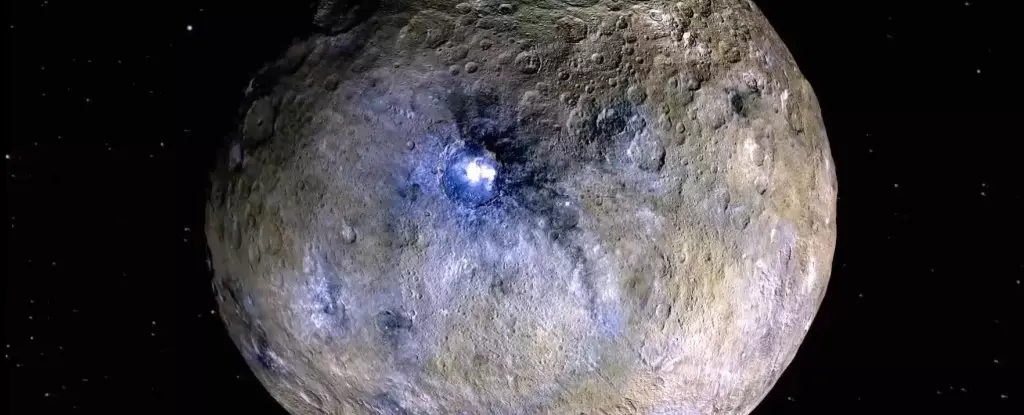Ceres, the largest object in the asteroid belt situated between Mars and Jupiter, has long intrigued scientists and astronomers alike. Discovered in 1801, this dwarf planet offers a fascinating contrast to its distant cousins, particularly due to its proximity to the Sun and its peculiar array of bright spots that hint at geological activity. Initially classified as an asteroid, Ceres was reclassified as a dwarf planet due to its large, rounded shape and significant mass – nearly half the size of Pluto. With seals of icy intrigue beneath its surface, Ceres may provide crucial insights into the nature of ocean worlds, replete with potential lessons about life beyond Earth.
Recent studies suggest that the surface of Ceres is composed predominantly of water ice, perhaps up to 90 percent of its crust. This revelation could transform the scientific understanding of this enigmatic dwarf planet. Previous models estimated the ice content to be no greater than 30 percent based on surface crater analysis, leading to the assumption that if Ceres were predominantly icy, its numerous craters would have smoothed over time, resembling more glacial landscapes typical of Earth. The prominent craters observed by NASA’s Dawn spacecraft, however, contradicted these expectations, indicating the possibility that the reality of Ceres is much more complex.
Mike Sori, a planetary geophysicist from Purdue University, posits that Ceres’s ice could maintain its structural integrity much longer than previously believed, especially when mixed with solid rock. This indicates that the presence of minor impurities can prevent flow, allowing craters to retain their well-defined shapes over billions of years – a striking departure from earlier models that expected ice-covered surfaces to demonstrate more morphological evolution.
The Dawn Mission and Its Importance
The Dawn spacecraft’s mission has proven pivotal in advancing our knowledge about Ceres. Arriving in 2015, the spacecraft provided detailed imaging and spectrometry data illustrating the dwarf planet’s surface characteristics. Through collaborative efforts among scientists, including Ian Pamerleau, new simulations were developed to better understand Ceres’s geological processes. These simulations posit that a crust rich in ice but interspersed with rocky minerals would inhibit the anticipated softening and flow of icy material.
By simulating various geological scenarios, researchers have proposed a gradational crust structure, where the ice content decreases with depth. This innovative modeling could explain how significant ice content can coexist with the preserved craters observed on the surface, offering a more accurate depiction of Ceres’s evolution over time.
The implications of the discoveries surrounding Ceres extend beyond our immediate understanding of this dwarf planet. The research indicates that Ceres might have once been akin to other known ocean worlds within the Solar System, such as Jupiter’s Europa and Saturn’s Enceladus. These celestial bodies are known or suspected to harbor subsurface oceans, kept liquid by geological activity stemming from tidal heating created by their parent planets.
In stark contrast, Ceres’s lack of tidal forces means that any ocean present would have since frozen, potentially forming a ‘muddy’ version of an ocean world trapped beneath a thick crust of ice. Sori elucidates that understanding Ceres’s history as an ocean world could potentially alter our preconceived notions of how ocean worlds can manifest and survive over time, suggesting greater variety among these distant siblings.
Another exciting dimension of Ceres lies in its accessibility for future exploration. Given its relatively short distance from Earth compared to other icy world candidates, Ceres presents a promising target for further investigation. The ability to investigate a nearby frozen ocean world provides scientists with a unique point of comparison to the more remote icy moons of our Solar System, perhaps facilitating discoveries about extraterrestrial environments capable of supporting life.
As researchers continue to unveil the hidden intricacies of Ceres through advanced technologies and renewed exploratory missions, it becomes acutely evident that this dwarf planet is not merely an asteroid. Instead, Ceres may represent an invaluable resource for our understanding of planetary science, evolution, and the potential for life beyond our planet.
Ceres stands as a testament to the complexity and diversity of celestial bodies within our Solar System. As scientists devise new models and interpretation strategies based on accumulating evidence, this dwarfed icy world emerges not only as an object of study but also as a beacon of hope in the search for extraterrestrial phenomena. With its recent findings, Ceres invites humanity to delve deeper into the mysteries of our cosmic neighborhood, potentially reshaping our understanding of icy worlds and their significance in the grander narrative of life beyond Earth.


Leave a Reply